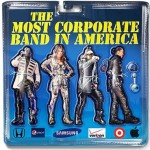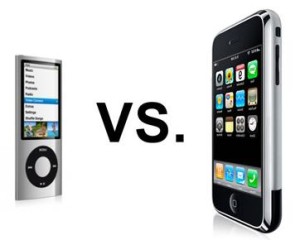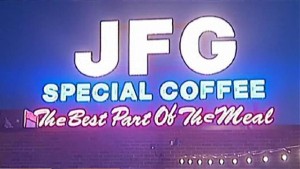Musical Festivals: A Branded Experience

In the 1960’s and 70’s, when music festivals began to rise in popularity, they were predominately about rebelling against commercial and corporate gimmicks, and primarily focused on peace, love and, of course, music. Fast forward to 2013 and corporate promotions and branded experiences are as synonymous with music festivals as the music itself.
Music festivals have become a multi-billion dollar industry and an excellent opportunity for brands to reach the hundreds-of-thousands of festival goers each year. Sponsorships for these festivals by big brands payoff for all parties involved. The festivals reap the benefits which, in turn, helps provide a better festival experience for attendees, and the attendees benefit from the amenities and giveaways (often festival essential) from the brands. What’s in it for the brands? Well, they gain awareness – and a lot of it.
A summer 2011 Havas Sports and Entertainment study and found that out of 2,244 respondents, only TWO didn’t notice any sponsorship while at a festival, 36 percent said they were more likely to purchase a sponsor’s product after experiencing their activation at the festival, and a whopping six out of every 10 brands on site could be recalled by fans.
Fredda Hurwitz, global VP of strategic planning, marketing & communications at Havas Sports commented: “Our research does much to dispel the view that music festivals are a dangerous arena for brand sponsors, and suggests brands are a welcome part of the festival experience if they develop activations that add value.”
Creating a memorable, exciting or unique experience at a music festival is what will set a successful sponsorship apart from those following the not-so-impactful route of traditional signage. When a fan attends a festival, they are seeking an experience, and that doesn’t stop at the bands they come to see, but is carried over to the brands they choose to interact with. There isn’t a right or wrong way to approach a festival sponsorship; to be successful, it just has to make sense. With summer music festivals kicking into high gear let’s take a look at three different types of brand sponsorships from one of the most popular (and branded) music festivals, Bonnaroo. You’ll see that each of these approaches provides a different, but equally creative way to promote brands.
- L’oreal Garnier Fructis: More than 80,000 people travel to a remote 700-acre farm in Tennessee each June for the Bonnaroo Music & Arts Festival. Knowing the attendees would be outside day and night listening music on multiple stages, Garnier Fructis provided practical services, such as free hair-washing and styling in a 40- by 40-foot air-conditioned tent. In an area where trees are scarce and the temperatures regularly reach 90+ degrees, the desire to cleanse yourself of yesterday’s sweat all of a sudden becomes pretty strong.
- Philips: Philips sponsored a silent disco at Bonnaroo. The company provided 400 of its new CitiScape Collection headphones for guests to wear to listen to tunes being spun by two DJs. In this situation attendees were able to experience firsthand the sound quality and silencing ability of the headphones in a fun, party-like atmosphere.
- Ford: Ford dubbed its tent at Bonnaroo "Destination Escape," playing on the name of its Escape vehicle that was displayed outside the tent. Inside, festivalgoers could cool off in the air-conditioned space, listen to live performances and charge their phones. While this essential phone charging service is not directly tied to what Ford’s Escape vehicle provides its users, it certainly generated a ton of exposure for the vehicle.
For additional info on other branded experiences at Bonnaroo, check out Bizbash’s slide show here, and to learn about sponsorships at other festivals, the online pub has produced a similar list extending past Bonnaroo.
Google’s Cover Band
Uh oh. Looks like Google Music showed up to the party wearing the same outfit as iTunes. Unfortunately for Google, the outfit looks better on iTunes. Not to mention Google brought the less attractive date (Google+).
For anyone who isn’t aware, Google recently launched its much anticipated digital music application, Google Music (original name, I know). Finally another music marketplace to rival iTunes – sounds great. But what makes Google Music different? Well, song costs are comparable to iTunes and the layout isn’t anything new. And unfortunately Google wasn’t able to get Warner Music Group to sign on the dotted line, which leaves a huge hole in their music offering (Cher, Cee Lo, Diddy, Green Day, Van Halen, to name a few). But Google knew all of this before launch, so I was curious to see how it would position itself in order to get consumers excited.
So what does make Google Music stand out? The short answer is: Nothing. After taking a look around the application, Google Music seems to be positioning itself as the “instant-anywhere, shareable music place.” It sounds accurate, but is it unique? Let's take a look.
- Instant-anywhere – This is no longer ownable. Although it’s extremely important, the ability to download songs and instantly listen on any device has become an expected feature. As a player 8 years late to the game, it’s unrealistic for Google Music to position itself around this idea.
- Shareable – This is a more interesting approach. iTunes is not known for being a social proponent, so there is some opportunity here. Google Music does have some cool share features; however, everything links to Google+, which has been a social wasteland since its launch. It also doesn’t help that Facebook’s strong partnership with Spotify seems to be changing the way people share and discover music.
All in all, Google Music isn’t giving consumers a strong enough reason to switch to their services - just an eerily similar alternative. They have a foundation, now they just need to find their niche and own it.
Sibling rivalry: iPods vs. iPhones
My mother is obsessed with her iPhone. While she taps away on her touchscreen all day, she asks me why I don’t trade in my "clearly less superior" iPod nano (5th generation) for Apple's newer flagship device. My typical response is that my iPod is my music device and nothing more, and that's the way I like it, thank you very much.
But then people started using Facebook from their iPhones. Then Angry Birds became popular to play on-the-go. Now, all of my friends have started playing Words with Friends (appropriately).
But me? I'm still here with my iPod. And I'm starting to think my mom has a point.
We are approaching an age of the all-or-nothing device. Phones aren't appealing to consumers unless they can offer Internet access, Skype capabilities, a slew of apps, e-mail, a GPS, video players, and music, just to name a few features. The basic iPod, which is only a music (and sometimes video) player, simply can't compete anymore, and so its brand is suffering a slow demise.
The iPhone, on the other hand, is so adept at meeting every technological need that Apple is willing to let the iPod brand be exceedingly eclipsed by the iPhone brand. Why would Apple invest time and money to revive an increasingly irrelevant iPod brand, when it can minimally advertise the lucrative iPhone and garner massive earnings?
By choosing to essentially leave its iPod brand strategy alone, Apple's sales are starting to reflect iPhone domination. Where iPod sales superseded those of iPhones by $13 million in 2010, that amount shrunk to only a $3 million difference in the first quarter of 2011. If the sales gap diminished that much in just one year, the outlook seems very favorable for iPhones.
The iPod brand's last saving grace could be its highly established brand image. Like it or not, iPhones will always have their roots from the iPod brand, both in name and in likeness – and many people will always refer collectively to the products as "iPod" devices. Even so, it will be difficult for iPods to hold their own in the coming years against their all-encompassing, digital successors.
Contributed by Allison Meeks
Lady Gaga: Branded this Way
Though she's been topping the charts with hits like "Bad Romance" and "Born this Way," Lady Gaga has claimed the #1 spot on a new list: The Forbes Celebrity 100. The 25-year-old pop sensation pushed Oprah to the #2 spot after earning $90 million in the last year. Oprah has been ranked No. 1 four times over the past seven years.
Whether you think she's a musical genius or a Madonna rip-off, you must admit that Lady Gaga has a strong personal brand. The mere mention of her name is instantly recognized by fans and critics alike. Lady Gaga has managed to be so successful and stand out from a slew of artists and singers by creating a personal brand that resonates with consumers. She embraces her strangest qualities and presents herself as the "Mother Monster" who is too fierce to let criticism bring her down.
And her numbers reflect this. Lady Gaga's concerts grossed $170 million and she sold an estimated 15 million albums worldwide. Her new album Born This Way hits stores later this month, but the title track is already the fastest-selling song in iTunes history, hitting one million downloads in just five days. And her "Little Monsters" (Lady Gaga fans) aren't the only ones with deep pockets. Lady Gaga's endorsement deals include Polaroid, Virgin Mobile, Monster Cable, Viva Glam, PlentyOfFish.com and a recent partnership with Starbucks.
Lady Gaga's brand is about embracing the outcasts who are teased, just like she was. Anyone who doesn't belong has a safe haven in Lady Gaga. She sings her personal story on stage, giving a voice to the socially disenfranchised. Lady Gaga knows her core values and plays to her strengths. She has created a unique personal brand that sets her apart from others in the music industry.
Lady Gaga made $200 million less than Oprah last year. What put her on the top was something money can’t buy: 32 million Facebook fans and over 10 million Twitter followers. Her social-media savvy is key to her success and building brand loyalty. Lady Gaga connects with her fans by tweeting all the time. It’s an important part of who she is and why she’s so famous. In the social media space, Lady Gaga trumps all celebrities, even Oprah with nearly 5.9 million Twitter followers.
With a strong personal brand, loyal fanbase and chart-topping social media presence, this monstrous brand is here to stay.
JFG Coffee Sign Returns
On Saturday, a Charlotte icon returned to the city's skyline and marked the beginning of Charlotte's Historic Preservation Month.
The JFG Special Coffee shines brightly again, now atop the VBGB Beer Hall & Garden at the North Carolina Music Factory.
The NC Music Factory was a natural fit for the 40-year-old sign because the area is made up of historic buildings that have been converted into venues for producing and enjoying music.
The JFG Coffee sign used to perch along I-277, near Bank of America Stadium. It was removed in 2009 with the hope of finding a new home and funding for its restoration. The mission to save the sign helped to spark a new campaign called Save Our Signs, which aims to preserve other vintage signs around the Queen City.
Another historic landmark benefiting from the emphasis on preservation is Reid's Fine Foods. It's sign at the Myers Park location was also relit over the weekend.
Is a Band a Brand?

......................................................................................................................................................................
According to Black Eyed Peas' frontman, will.i.am, his most definitely is. In a recent article published by The Wall Street Journal will.i.am defines his approach to corporate sponsors, "I consider us a brand. A brand always has stylized [PowerPoint] decks, from colors to fonts. Here's our demographic. Here's the reach. Here's the potential. Here's how the consumer will benefit from the collaboration." This approach has proved successful for the man who Randy Phillips, president and CEO of the concert promoter AEG Live, says could be "the best ad executive on Madison Avenue." Not only do the Black Eyed Peas (or their songs) appear in partnership with giants like Coors, Levi's, Honda, Apple, Verizon and Pepsi, but corporate sponsor "shout outs" have become a regular part of the live show. In the first half of every show will.i.am delivers a freestyle rap he creates from text messages scrolling on two large screens on-stage. The text messages are delivered by BlackBerry, the tour's primary sponsor. The band also works in the company's tagline "Love What You Do" into the seemingly impulsive monologue during the group's performance of "Where Is The Love." The Black Eyed Peas even performed a concert in Times Square for the sole purpose of promoting a new Samsung product.
For an industry of artists who have reported "it's all about the music", this band leader has been quoted as saying corporate partnerships are equally as important as music sales. What do you think? Savvy celebrity or sellout? Can a band be a brand?
Contributed by: Allison Jobes
Did slot miss their shot?
Remember mixed tapes? The old school cassettes made for friends containing your favorite songs, with clever titles such as "Road Trip Mix 91"?
Fast forward 20+ years and enter slotRadio. From the looks of their advertising, the new music player + music card is targeting moms ... busy moms in particular (although really, what mom today ISN'T busy?). I fall into this category, and it seriously took reading the ad several times plus a visit to their website to help me understand exactly WHAT they were selling. Is slotRadio a music player? Actual music? A big idea?
It's really all three. slotRadio is a music player, with special "pre-filled" cards loaded up with music from specific categories. For example, I can choose a card with 1000 country-specific songs ready to play in my slotRadio player. Or a health and fitness card that has seven playlists created with specific activities in mind (cardio, cooldown, yoga, etc.). Great concept. Appropriate target. So what's the problem?
The name. slotRadio. Sure it's descriptive. Yes, it's functional. But this is a category definer. No other manufacturer has a product like this. Imagine if Procter & Gamble had chosen to use "Dust-Trapping-Cloth-on-a-Stick" for their inventive product in 1999.
To make things even more confusing, the pre-loaded cards are branded slotRadio, as is the player. But the slotRadio card can actually be played on the Sansa Fuze and the Sansa Clip+. Seems to me a better option would have been to name the player slotRadio, and give the card (new, unique, different) a (new, unique, different) name.
Apple defined the personal music category with the iPod. Now SanDisk has a chance to redefine the playlist. Unfortunately I think the choice of name leaves the door wide open for a second player to come in and dominate with a more original brand name.
Band Brands
Take a peek at your music library: you’ll be amazed at how many familiar naming strategies you spot. Here are a few of my favorites:
REPETITION
Hot Hot Heat
Mr. Mister
Go-Gos
Duran Duran
RHYMING
Milli Vanilli
Lynard Skynard
Quiet Riot
Read more


